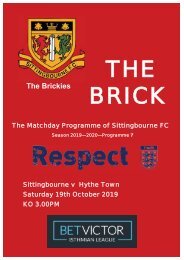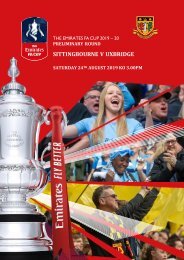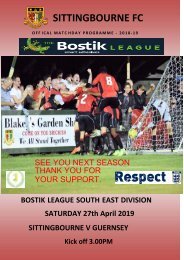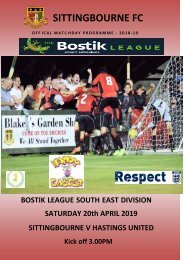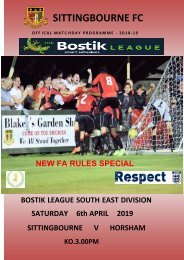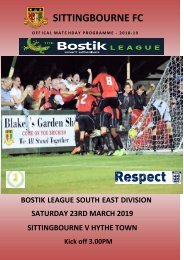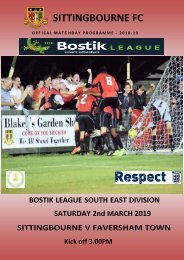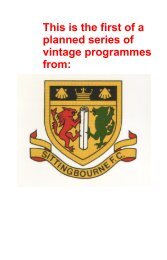tooting261019
Match Day programme, Sittingbourne v Tooting & Mitcham Utd Saturday 26th October 2019
Match Day programme, Sittingbourne v Tooting & Mitcham Utd Saturday 26th October 2019
- No tags were found...
You also want an ePaper? Increase the reach of your titles
YUMPU automatically turns print PDFs into web optimized ePapers that Google loves.
Wembley, and the Advent of Big Match Programmes<br />
We have previously noted that the FA were reluctant to get involved in programme production<br />
for FA Cup Finals, but that changed in 1923 when Wembley opened, albeit the publishers of<br />
cup final and international issues from that venue were the stadium authorities themselves,<br />
with FA approval. The scale and design of these programmes matched that of the venue. For<br />
the first time, colour appeared on British programme covers, and the contents were more substantial<br />
with more photographs and greater coverage of players.<br />
Wembley opened with the famous 1923 Cup Final, and the programme for that fixture comprised<br />
28 pages, arguably the most pages published to that date. It should be noted, in passing,<br />
that this truly is the “Penny Black” of programme collecting - it is the most famous item, but<br />
by no means the rarest nor most expensive nor coveted.<br />
Host clubs continued to issue programmes for Cup semi-finals and international and representative<br />
matches played at their grounds (until the 1950’s the majority of England international<br />
matches were played on club grounds).The host clubs had merely issued similar, if not identical,<br />
programmes to their standard League issues, but the example shown by Wembley spurred<br />
them into making a special effort for the big games entrusted to their care.<br />
An example of this is Chelsea, who maintained the same 4 or 8- page, blue print on white paper,<br />
programme style until after the Second World War. In October 1934, they staged the English<br />
League v Scottish League match at Stamford Bridge, and issued a special programme<br />
comprising the normal 8 pages, but with photographs on the centre and front pages, and red<br />
print as well as the standard blue on the front cover. Price remained at the standard 2d.<br />
Wembley programmes were not only the first to use full colour, but they also saw a rich variety<br />
of programme designs. All of the pre-Second World War covers relied on sketches and<br />
graphics, with photographs used sparingly, and some of the full colour sketches were very attractive<br />
indeed. Almost all of them featured the “twin towers” in some form or another, whether<br />
in a photograph (1925), logo (1935) or as background (1933 and 1931). Most years saw an advertisement<br />
at the bottom of the front page - either “Drink Bovril. Once it’s in you it’s sinew” or<br />
“Expert Criticism of today’s cup tie by Charles Buchan in the Daily News (or News Chronicle)”<br />
The example set by Wembley ensured that from then on big match programmes would invariably<br />
fit the occasion they sought to represent, and programme buyers could anticipate something<br />
superior to the normal League fare.<br />
For more information and advice on programmes and programme collecting, please visit<br />
www.pmfc.co.uk.





